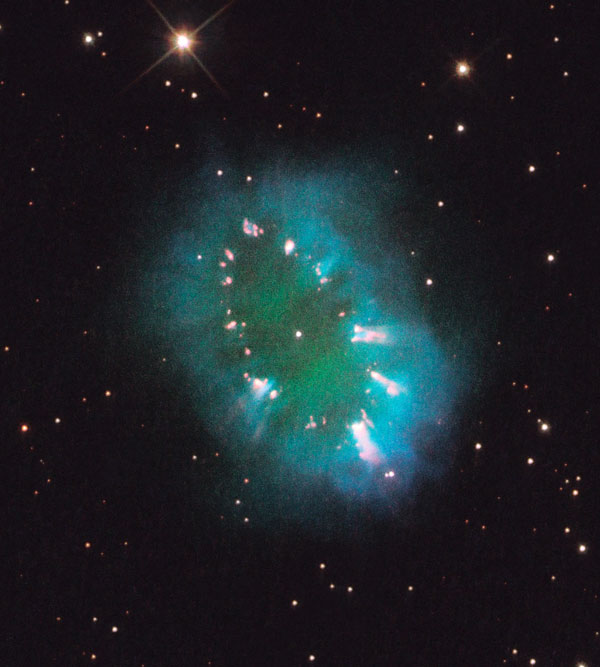Key Takeaways:
The object, aptly named the Necklace Nebula, is a recently discovered planetary nebula, the glowing remains of an ordinary, Sun-like star. The nebula consists of a bright ring, measuring 12 trillion miles (19 trillion kilometers [2 light-years]) across, dotted with dense, bright knots of gas that resemble diamonds in a necklace. The knots glow brightly due to absorption of ultraviolet light from the central stars.
A pair of stars orbiting close together produced the nebula, also called PN G054.2-03.4. About 10,000 years ago, one of the aging stars ballooned to the point where it enveloped its companion star. This caused the larger star to spin so fast that much of its gaseous envelope expanded into space. Due to centrifugal force, most of the gas escaped along the star’s equator, producing a dense ring. The embedded bright knots are the densest gas clumps in the ring.
The stars are furiously whirling around each other, completing an orbit in a little more than a day. (For comparison, Mercury takes 88 days to orbit the Sun.)
The Necklace Nebula is located 15,000 light-years away in the constellation Sagitta the Arrow.
The object, aptly named the Necklace Nebula, is a recently discovered planetary nebula, the glowing remains of an ordinary, Sun-like star. The nebula consists of a bright ring, measuring 12 trillion miles (19 trillion kilometers [2 light-years]) across, dotted with dense, bright knots of gas that resemble diamonds in a necklace. The knots glow brightly due to absorption of ultraviolet light from the central stars.
A pair of stars orbiting close together produced the nebula, also called PN G054.2-03.4. About 10,000 years ago, one of the aging stars ballooned to the point where it enveloped its companion star. This caused the larger star to spin so fast that much of its gaseous envelope expanded into space. Due to centrifugal force, most of the gas escaped along the star’s equator, producing a dense ring. The embedded bright knots are the densest gas clumps in the ring.
The stars are furiously whirling around each other, completing an orbit in a little more than a day. (For comparison, Mercury takes 88 days to orbit the Sun.)
The Necklace Nebula is located 15,000 light-years away in the constellation Sagitta the Arrow.










